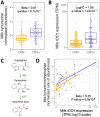This is a preprint.
Human Cytomegalovirus in breast milk is associated with milk composition, the infant gut microbiome, and infant growth
- PMID: 37503212
- PMCID: PMC10370112
- DOI: 10.1101/2023.07.19.549370
Human Cytomegalovirus in breast milk is associated with milk composition, the infant gut microbiome, and infant growth
Update in
-
Human cytomegalovirus in breast milk is associated with milk composition and the infant gut microbiome and growth.Nat Commun. 2024 Jul 23;15(1):6216. doi: 10.1038/s41467-024-50282-4. Nat Commun. 2024. PMID: 39043677 Free PMC article.
Abstract
Human cytomegalovirus (CMV) is a highly prevalent herpesvirus that is often transmitted to the neonate via breast milk. Postnatal CMV transmission can have negative health consequences for preterm and immunocompromised infants, but any effects on healthy term infants are thought to be benign. Furthermore, the impact of CMV on the composition of the hundreds of bioactive factors in human milk has not been tested. Here, we utilize a cohort of exclusively breastfeeding full term mother-infant pairs to test for differences in the milk transcriptome and metabolome associated with CMV, and the impact of CMV in breast milk on the infant gut microbiome and infant growth. We find upregulation of the indoleamine 2,3- dioxygenase (IDO) tryptophan-to-kynurenine metabolic pathway in CMV+ milk samples, and that CMV+ milk is associated with decreased Bifidobacterium in the infant gut. Our data indicate a complex relationship between milk CMV, milk kynurenine, and infant growth; with kynurenine positively correlated, and CMV viral load negatively correlated, with infant weight-for-length at 1 month of age. These results suggest CMV transmission, CMV-related changes in milk composition, or both may be modulators of full term infant development.
Conflict of interest statement
Declaration of interests The authors declare no competing interests.
Figures





References
-
- Zuhair M. et al. Estimation of the worldwide seroprevalence of cytomegalovirus: A systematic review and meta-analysis. Rev. Med. Virol. 29, e2034 (2019). - PubMed
-
- Sinzger C. et al. Fibroblasts, epithelial cells, endothelial cells and smooth muscle cells are major targets of human cytomegalovirus infection in lung and gastrointestinal tissues. J. Gen. Virol. 76 (Pt 4), 741–750 (1995). - PubMed
-
- Hamprecht K. & Goelz R. Postnatal Cytomegalovirus Infection Through Human Milk in Preterm Infants: Transmission, Clinical Presentation, and Prevention. Clin. Perinatol. 44, 121–130 (2017). - PubMed
-
- Hamprecht K., Witzel S., Maschmann J., Speer C. P. & Jahn G. Transmission of Cytomegalovirus Infection Through Breast Milk in Term and Pretern Infants. in Short and Long Term Effects of Breast Feeding on Child Health (eds. Koletzko B., Michaelsen K. F. & Hernell O.) 231–239 (Springer US, 2002).
Publication types
Grants and funding
LinkOut - more resources
Full Text Sources
Research Materials
